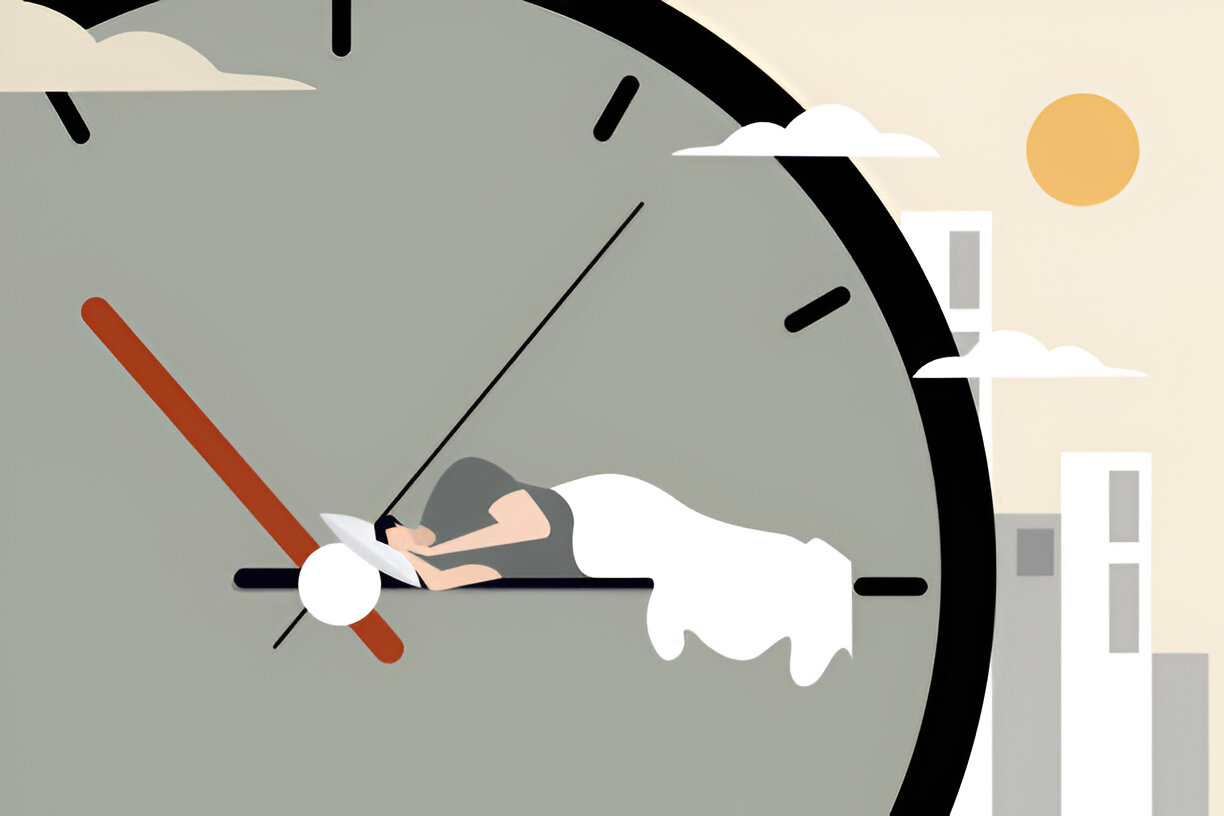We are all familiar with the feeling of needing a short nap for some extra energy after a long day at work or an especially hard morning workout, and it turns out we are not alone. According to the National Sleep Foundation, 63% of Americans take a nap.
But how long should a nap be when you nap? Is there an ideal length of time for a nap? Today, we will explain the science of napping and nap length, followed by some simple suggestions and techniques for those who are beginning a napping routine.
Napping and Sleeping
Napping and sleeping are two ways we all experience rest in our lives and both involve closing our eyes, resting our bodies and going to sleep. Although napping and sleeping may sound like the same activity, there are some key differentiations in napping and sleeping.
Let us first define napping and sleeping. Napping is a short sleep at any time of day, and normally lasts for a period of time between 10 and 30 minutes. Sleeping, on the other hand, is usually long (unconsciousness), typically when sleeping at night for several hours.
Aspect |
Napping |
Sleeping |
|---|---|---|
| Duration | Typically shorter (20-30 minutes) | Typically longer (6-9 hours) |
| Purpose | Recharge and boost alertness | Restore energy and promote health |
| Sleep Stages | Primarily light sleep | Includes deep and REM sleep stages |
| Frequency | Occasional throughout the day | Nightly, usually once per 24-hour cycle |
| Benefits | Improves alertness and cognitive function | Supports overall health and well-being |
| Consistency | Can vary in timing and frequency | Typically consistent nightly routine |
What is Considered a "Power Nap" for Adults?
Experts recommend that adults should take a nap for no more than 20 minutes. A power nap refers to a short nap of 15 to 20 minutes. This is when we enter a light stage of sleep known as NREM (non-rapid eye movement) sleep, which is the perfect balance between relaxation and being awake.
When we take a power nap, our brain waves slow down and give our mind and body a chance to rest and recharge. We can quickly feel more alert and focused after taking a power nap.
Research suggests that a 20-minute power nap can improve memory, creativity, and cognitive function in general. A 20-minute power nap is especially good for those individuals who did not sleep well the night before or felt sleepy after lunch.
In addition to the cognitive benefits of taking a power nap, the 20-minute is the ideal time for a nap. Napping is also good for your mood and may help reduce stress levels.
It can help to increase the production of a mood-regulating hormone called serotonin and decrease the production of a stress hormone called cortisol. As a result, we wake up feeling rejuvenated and in a better mood overall.

Types of Naps
People can incorporate several types of napping into their routines, each serving different purposes and durations. Here are some common types of napping:
Nap Type |
Duration |
Benefits |
Best For |
|---|---|---|---|
| Planned (Preparatory) | 20-30 minutes | Prevents fatigue later in the day and enhances alertness and productivity. | Individuals with scheduled late-night activities. |
| Emergency | 10-20 minutes | Quickly restores alertness and reduces the risk of accidents due to sleepiness. | When sudden tiredness or drowsiness occurs. |
| Habitual | 10-30 minutes | Promotes consistent sleep patterns and improves overall sleep quality. | Those aiming for daily rest and rejuvenation. |
| Recovery | 30-90 minutes | Compensates for inadequate nighttime sleep and boosts mood and energy levels. | After a night of poor sleep or physical exertion. |
| Appetitive | 10-20 minutes | Provides relaxation and rejuvenation and enhances overall well-being. | Anyone seeking a refreshing break during the day. |
| Learning Improvement | 10-20 minutes | Enhances memory consolidation and retention of learned information. | Students and professionals after teaching tasks. |
| Prophylactic | 10-20 minutes | Maintains optimal alertness and prevents fatigue during demanding periods. | Before engaging in mentally or physically taxing activities. |
Benefits of Napping
Napping for a brief period during the day can provide a variety of advantages for both physical and mental well-being. Many people who have found success and high productivity, such as Albert Einstein, Winston Churchill, and Leonardo da Vinci, were known to take naps every day. Here are some advantages of naps:
1. Improved focus and productivity
Napping can help restore alertness and cognitive performance. A nap that lasts 20-30 minutes can add energy and help you remain focused and productive for the rest of the day. This can be useful for people who have been working long hours or have had a busy daily schedule.
2. Enhanced memory and learning
Sleep is key for processing learned material and committing it to memory; that is, sleep has a fundamental importance in the process of learning. Napping reinforces this process by allowing the brain time to process and store learned material.
A study by the University of California, Berkeley, found that nap durations of 90 minutes can improve memory and learning.
3. Lowered stress and anxiety
Chronic stress and anxiety can adversely affect physical and mental health. A nap can provide a break from daily demands and responsibilities, allowing the body and mind time to relax and recover, which helps to alleviate stress and anxiety.
4. Increased creativity
Napping can increase creativity and problem solving abilities. A study published in Nature Neuroscience found that naps provide the brain with a time to make new connections in response to new stimuli leading to more creative work. So the next time you are stuck on a project and need some creative energy, take a nap.
5. Lowered risk of heart disease
Studies have established a connection between inadequate sleep and higher incidences of heart disease and some other health conditions. Taking a nap can help offset inadequate sleep contributing to improved overall sleep quality leading to reduced risk of heart disease and some other health conditions.

6. Improved mood and emotional well-being
Not enough sleep can result in irritability, mood swings, and negative emotions. A nap can help improve mood and emotional well-being. A study published in the Journal of Sleep Research found that people who took naps regularly felt more positive and had less stress and depression.
7. Enhanced physical performance
Napping can also improve physical performance. A study published in the journal Sleep reported that athletes who took a 30-minute nap prior to practicing in the afternoon or competing were more alert and engaged physically than those who did not nap.
8. Stronger immune system
Quality sleep is vital for a strong immune system. Napping can help replace sleep loss and develop consistent sleep patterns. This can help improve the immune system and reduce the likelihood of illness and infection.
9. Minimized chance of accidents
Drowsy driving is a major contributor to accidents while driving. The preventive benefits of napping can help to avoid drowsiness and fatigue-related accidents. A short nap prior to a long drive, or taking a nap during a break, can greatly enhance alertness and concentration while driving.
10. Convenient and inexpensive
Napping is a convenient and inexpensive way to boost mental and physical well-being. It does not require special equipment or resources, and can easily be worked into your daily routines. A short nap can be beneficial to both body and mind, for no cost.
Pros |
Cons |
|---|---|
| Increases alertness | Risk of sleep inertia (grogginess) |
| Improves mood | Disruption of nighttime sleep patterns |
| Enhances learning and memory | Dependency on naps for energy |
| Aids physical recovery | Time constraints for some individuals |
| Convenient and flexible | Cultural or social stigma against napping |
Napping Tips
- Select an Optimal Time: Choose a nap time in the early afternoon, usually between 1 pm and 3 pm, when your body might be more prone to feeling tired or sleepy.
- Establish a Comfortable Environment: Find a comfortable, quiet room, or use a sleep mask and ear plugs to block out any noise and light.
- Make it Short: Try to keep your nap short (about 10 to 30 minutes) and not long enough to enter a deep sleep, which would cause you to wake up feeling drowsy.
- Choose a Comfortable Place: Lay comfortably on a bed, sofa, or recliner with a pillow positioned under your head and neck.
- Implement Relaxation Techniques: Prior to taking a nap, bring your body and mind to a state of relaxation by utilizing deep breathing, progressive muscle relaxation (when appropriate), or visualization.
- Keep the Temperature Comfortable: Change the temperature of the room or have a light blanket nearby to ensure that you don't get too hot or cold while you are napping.
- Limit Caffeine: Stay away from caffeine for a few hours before your nap, which can affect the quality of your sleep.
- Develop a Nap Habit: Nap at the same time every day to strengthen the sleep routine and help your body to settle into the sleep and nap process.
- Ease Out of Sleep: Use a gentle alarm or wake-up app that slowly ramps up the sound so that you do not wake up suddenly and feel confused.
How Important is a Good Pillow for a Good Nap?
A good pillow will help tremendously with a good nap, because it is more comfortable and helps assist with proper alignment for your head and neck. Here are some reasons for using a good pillow:
- Comfort: A comfortable pillow will allow you to relax and take a more efficient nap. It should be about the right firmness and soft enough depending on preference.
- Neck Support: Proper neck support will help with spinal alignment and it will decrease strain and discomfort that may wake or interrupt your nap.
- Temperature Regulation: Some pillows are designed with specific materials that help regulate temperature and keep you cool and comfortable while napping.
- Allergen Control: Hypoallergenic pillows will reduce allergens like dust mites and will help to provide a cleaner and healthier sleeping environment.
- Long-Term Health: Continuously using a proper, supportive pillow will improve your long-term neck health, and may help you to be less likely to wake with stiffness or soreness.
Final Thoughts
Naps can be an excellent way to increase alertness and improve mood. If you want to obtain optimal revitalization without the risk of disruption of sleep stages into deep sleep, then a two- to zero-minute nap is suggested.
Knowing the different napping categories, like preparatory naps before staying up late and recovery naps after exercise, has helped to customize napping tendencies and preferences based on individual needs.
Creating an environment and implementing relaxation approaches to maximize the benefits of taking a nap is essential to support overall sleep quality and not detract from daily functioning and productivity.













